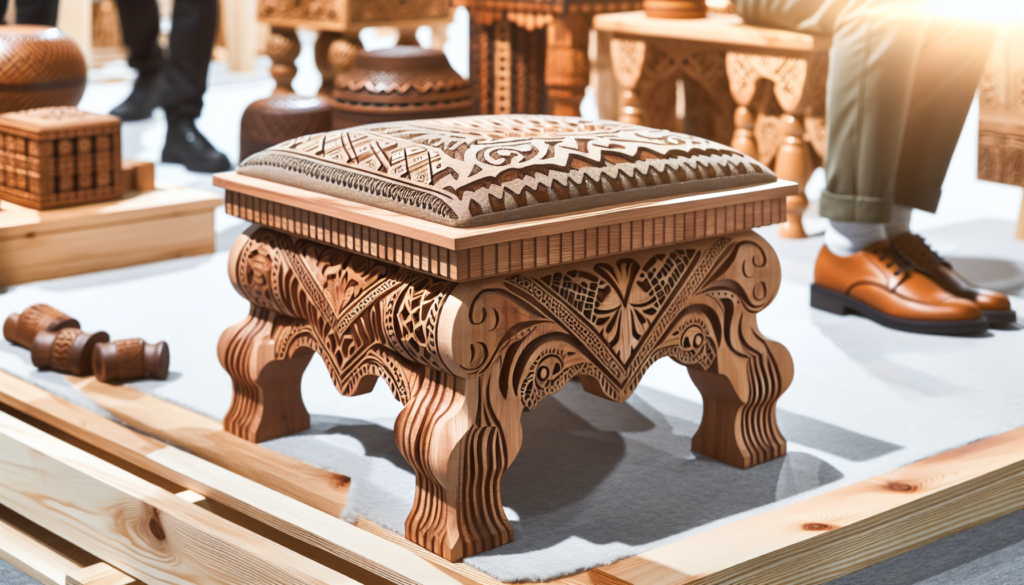Have you ever wondered what to do with that unused wooden footstool or ottoman lying around in your living room? If you’re looking for some creative ideas to spruce up your space, look no further! In this article, we will explore a range of innovative projects that you can undertake with a wooden footstool or ottoman. Whether it’s transforming it into a stylish plant stand, repurposing it as a unique bedside table, or even using it as a canvas for your artistic talents, the possibilities are endless! So, grab your toolkit and let’s dive into the world of wooden footstool and ottoman creations!
Exploring Different Designs
Structured Stool or Ottoman
When it comes to wooden footstools or ottomans, one design option is a structured stool or ottoman. This design usually features clean lines and geometric shapes, creating a modern and minimalist look. The seat is often made of solid wood, with sturdy legs that provide stability. A structured stool or ottoman can be a great addition to any contemporary living space or office, as it adds a touch of sophistication and elegance.
Carved Stool or Ottoman
For those who appreciate intricate details and craftsmanship, a carved stool or ottoman is an excellent choice. This design showcases the beauty of the wood through intricate carvings and engravings. From floral motifs to geometric patterns, the possibilities are endless. A carved wooden stool or ottoman can serve as a statement piece in any room, adding a touch of artistic flair and elegance.
Sleek and Minimalistic Stool or Ottoman
If you prefer a more simplistic yet stylish design, a sleek and minimalistic stool or ottoman might be the perfect choice for you. This design typically features clean lines, smooth surfaces, and a minimalistic silhouette. The focus is on the natural beauty of the wood, with little to no embellishments or decorative elements. A sleek and minimalistic footstool or ottoman can create a sense of calm and serenity in your living space, making it the ideal spot to relax and unwind.
Incorporating Multi-functionality
Storage Compartment Stool or Ottoman
Incorporating multi-functionality into a wooden footstool or ottoman can be incredibly practical and convenient. One popular option is a storage compartment stool or ottoman. These pieces often have a hinged top or removable cushion, revealing ample space for storing blankets, books, or other household items. Not only does this design provide a comfortable seating option, but it also helps keep your space organized and clutter-free.
Convertible Stool or Ottoman
If you’re looking for versatility, a convertible stool or ottoman might be just what you need. This design can transform from a footstool or low seat into a full-sized ottoman or even a coffee table. With a simple adjustment or flip, you can easily switch between different functions, making it an excellent choice for small living spaces or rooms that require flexible furniture options. A convertible wooden footstool or ottoman is an innovative and practical addition to any home.
Built-in Tray Stool or Ottoman
Do you often find yourself in need of a stable surface for placing drinks or snacks? A built-in tray stool or ottoman could be the perfect solution. This design features a flat and sturdy tray built into the top surface of the stool or ottoman. When not in use, the tray seamlessly blends into the overall design. However, when needed, it provides a convenient space for serving food or drinks to your guests. A built-in tray wooden footstool or ottoman combines style with functionality, creating a practical and aesthetically pleasing piece of furniture.

Enhancing Comfort and Style
Cushioned Stool or Ottoman
Comfort is key when it comes to footstools and ottomans, and a cushioned stool or ottoman ensures a cozy and relaxing experience. This design incorporates a padded seat or cushioned top, providing extra support and comfort for your feet. You can choose from various upholstery options, such as plush fabrics or soft leather, to match your desired style and level of comfort. A cushioned wooden footstool or ottoman is a perfect addition to any living room or bedroom, adding both functionality and style.
Upholstered Stool or Ottoman
Upholstered stools or ottomans offer endless possibilities for customization and personalization. This design allows you to choose from a wide range of fabrics, patterns, and colors to match your existing decor or create a statement piece. Whether you prefer a bold and vibrant upholstery or a more subtle and neutral tone, there’s an option for every taste. An upholstered wooden footstool or ottoman brings a touch of luxury and elegance to any space, making it a versatile and stylish addition to your home.
Decorative and Painted Stool or Ottoman
If you’re looking to add a pop of color or a decorative element to your living space, a decorative and painted stool or ottoman is the way to go. This design allows for endless creativity, as you can choose to paint intricate patterns, motifs, or even scenic landscapes on the wooden surface. Whether you opt for a hand-painted design or a stenciled pattern, a decorative and painted wooden footstool or ottoman can become a focal point and conversation starter in any room.
Customizing the Footstool or Ottoman
Incorporating Unique Materials and Finishes
To make your wooden footstool or ottoman truly unique, consider incorporating unique materials and finishes. You can combine wood with other materials such as metal, glass, or even natural fibers like rattan or jute. By choosing contrasting materials, you can create a visually striking piece that stands out in any room. Additionally, experimenting with different finishes, such as distressed or weathered looks, can add character and charm to your footstool or ottoman.
Adding Personalized Engravings or Designs
Add a personal touch to your wooden footstool or ottoman by adding personalized engravings or designs. Whether it’s your initials, a meaningful quote, or a special symbol, engraving it onto the wood can make it truly one-of-a-kind. You can also consider adding designs through wood burning or carving techniques. By incorporating personalized elements, you can create a footstool or ottoman that reflects your individuality and adds sentimental value to your space.
Customizing Footstool or Ottoman Dimensions
Every space has unique dimensions and requirements, and customizing the dimensions of your wooden footstool or ottoman can ensure a perfect fit. Consider adjusting the height, width, or depth to suit your specific needs and preferences. Whether you need a taller footstool for better support or a narrower ottoman to fit in a tight corner, customizing the dimensions allows you to create a piece that complements your space perfectly.

DIY Wooden Footstool or Ottoman Projects
Simple Wooden Footstool
If you enjoy woodworking and want to try your hand at a DIY project, a simple wooden footstool is a great place to start. This beginner-friendly project typically involves creating a sturdy base with four legs and attaching a flat wooden seat. You can personalize the design by adding decorative elements or applying a unique finish. This project not only allows you to showcase your craftsmanship but also provides a practical and functional piece of furniture for your home.
Reclaimed Wood Ottoman
For an environmentally friendly and rustic touch, consider building a reclaimed wood ottoman. This project involves sourcing reclaimed wood and repurposing it into a stylish and sustainable piece of furniture. You can arrange the wooden boards in a variety of patterns, such as herringbone or chevron, to create an eye-catching design. The natural weathering and imperfections of reclaimed wood add character and charm to the ottoman, making it a unique and eco-friendly addition to your living space.
Pallet Wood Footstool
If you’re looking for an affordable and creative project, consider making a pallet wood footstool. Pallets are readily available and can be transformed into a stylish and functional footstool with a little bit of woodworking skill. You’ll need to disassemble the pallet, cut the pieces to the desired dimensions, and then assemble them into a sturdy base. The rustic and textured appearance of pallet wood adds a touch of warmth and charm to the footstool, making it a perfect addition to any farmhouse or eclectic decor.
Choosing the Right Wood
Hardwood Options
When selecting the wood for your footstool or ottoman, hardwood options are a common choice due to their durability and strength. Popular hardwood options include oak, walnut, cherry, and maple. Each type of wood has its unique characteristics, such as grain patterns and color variations, allowing you to choose the one that best suits your desired aesthetic. Hardwood not only ensures the longevity of your footstool or ottoman but also adds a natural and timeless beauty to your space.
Softwood Options
While softwoods are generally less dense and more prone to scratching or denting, they can still be suitable for footstools or ottomans, especially if you prioritize affordability. Softwood options, such as pine or cedar, offer a lighter and more budget-friendly alternative. These types of wood can still be durable and visually appealing when properly finished and maintained. Softwood footstools or ottomans can bring a sense of warmth and coziness to your living space.
Exotic Wood Types
For those who want to make a statement with their footstool or ottoman, consider exotic wood types. Exotic woods, such as mahogany, teak, or padauk, offer distinctive grain patterns and unique colors that can instantly elevate the visual appeal of your furniture piece. Keep in mind that exotic woods can be more expensive and may require special care. However, their striking beauty and rarity make them worth considering for those seeking a truly exceptional and luxurious wooden footstool or ottoman.

Basic Tools and Materials for Construction
Essential Woodworking Tools
To embark on a wooden footstool or ottoman project, it’s essential to have the right tools. Some of the basic woodworking tools you’ll need include a tape measure, a miter saw or circular saw, a drill or driver, a sander, clamps, and a chisel. These tools will help you measure, cut, assemble, and finish your footstool or ottoman. It’s important to ensure you have the necessary tools and practice safety precautions when using them.
Supporting Materials and Hardware
In addition to woodworking tools, you’ll also need supporting materials and hardware for constructing your footstool or ottoman. These may include wood glue, screws or nails, sandpaper, wood filler, hinges or lid supports for storage compartment designs, and foam or padding for cushioned or upholstered designs. Depending on your chosen design, you may need additional materials such as upholstery fabric, stain, or varnish. Collecting all the necessary materials and hardware in advance will make your construction process smoother and more efficient.
Safety Equipment
Working with tools and materials requires safety precautions to protect yourself. Some essential safety equipment includes safety glasses or goggles, a dust mask, and ear protection. These items will help prevent any potential injuries or health hazards during the construction process. It is important to prioritize safety and follow proper safety guidelines while working on your footstool or ottoman project.
Step-by-Step Construction Guide
Measuring and Cutting Wood Pieces
The construction process begins with measuring and cutting the wood pieces according to your desired dimensions. Start by measuring the length, width, and height of the footstool or ottoman. Mark these measurements on the selected wood and use a miter saw or circular saw to make accurate cuts. Ensure that all the pieces are cut to the exact measurements to ensure stability and proper assembly.
Assembly and Joinery Techniques
Once you have cut the wood pieces, it’s time to assemble your footstool or ottoman. Depending on your chosen design, you may need to use techniques such as butt joints, miter joints, or dowel joinery to connect the wooden pieces securely. Apply wood glue to the joints before using screws or nails to reinforce the connections. It is important to follow proper assembly techniques to ensure the strength and stability of your footstool or ottoman.
Finishing and Polishing
After the footstool or ottoman is assembled, it’s time to sand the wood surfaces to achieve a smooth finish. Start with coarse-grit sandpaper and gradually move to finer grits for a polished result. Remove any rough edges or imperfections during the sanding process. Once the wood is smooth, apply a stain or varnish of your choice to protect the surface and enhance the natural beauty of the wood. Follow the manufacturer’s instructions for the specific stain or varnish you are using.

Finishing and Upholstering Techniques
Staining and Varnishing
To complete the construction process, apply a stain or varnish to your wooden footstool or ottoman. Staining enhances the natural color and grain of the wood, providing a rich and warm finish. Choose a stain color that complements your existing decor or matches the desired aesthetic. Apply the stain evenly using a brush or rag, following the wood’s grain pattern. Allow the stain to penetrate the wood and then wipe off any excess. Once the stain is dry, apply multiple coats of varnish for a durable and glossy finish.
Upholstery Basics
If you’ve chosen a footstool or ottoman design that includes upholstery, it’s important to understand the basics of upholstery. Start by cutting upholstery foam or padding to fit the wooden seat. Secure the foam in place using spray adhesive or upholstery glue. Next, cut upholstery fabric larger than the wooden seat, allowing for some excess fabric to wrap around the edges. Pull the fabric tightly over the foam and wooden seat, securing it to the underside with staples or upholstery tacks. Trim any excess fabric for a clean and professional look.
Creative Upholstery Ideas
While basic upholstery is practical, you can take your footstool or ottoman to the next level by exploring creative upholstery ideas. Consider using patterned or textured fabrics to add visual interest and unique touches to your piece. You can also experiment with tufting techniques to create a buttoned or quilted appearance. Adding decorative trims, such as piping or nailhead trim, can further enhance the overall aesthetic. Don’t be afraid to let your creativity shine when it comes to upholstery, as it can truly transform the look of your wooden footstool or ottoman.
Maintenance and Care Tips
Cleaning and Dusting
To keep your wooden footstool or ottoman looking its best, regular cleaning and dusting are essential. Use a soft cloth or feather duster to remove dust and debris from the surface of the wood. Avoid using abrasive materials or harsh chemicals that could damage the finish. For stubborn stains or spills, gently wipe the affected area with a damp cloth and mild soap, then dry it thoroughly. Regular cleaning will help maintain the beauty and longevity of your footstool or ottoman.
Preventing Damage and Moisture
Wood is susceptible to moisture, which can cause warping or staining. To prevent damage, avoid placing your wooden footstool or ottoman in areas prone to moisture, such as bathrooms or near windows. Use coasters or placemats to protect the wood surface from hot or wet items. Additionally, avoid exposing the footstool or ottoman to direct sunlight for extended periods, as this can lead to fading or discoloration. Taking proper preventative measures will help prolong the lifespan of your wooden furniture.
Reapplying Protective Coatings
Over time, protective coatings such as varnish or stain may wear off or become damaged. To maintain the long-term beauty and protection of your footstool or ottoman, consider periodically reapplying protective coatings. Before applying a new coat, ensure the wood surface is clean and dry. Lightly sand any rough areas or old finish, and then brush on a fresh coat of stain or varnish. Follow the manufacturer’s instructions regarding drying time and the number of recommended coats. Reapplying protective coatings will enhance the durability and appearance of your wooden footstool or ottoman.
In conclusion, wooden footstools and ottomans offer a wide range of design options, ensuring there is a perfect piece for every style and functionality preference. By exploring different designs, incorporating multi-functionality, enhancing comfort and style, customizing dimensions, and selecting the right wood and materials, you can create a wooden footstool or ottoman that perfectly complements your living space. Additionally, DIY projects allow for personalization and a sense of accomplishment. Whether you choose a simple wooden footstool or an intricate reclaimed wood ottoman, these projects can provide both satisfaction and a unique addition to your home. Remember to prioritize safety, follow step-by-step construction and finishing techniques, and maintain your wooden footstool or ottoman with regular cleaning and preventative measures. With proper care, your wooden footstool or ottoman will continue to bring comfort, style, and functionality to your living space for years to come.


